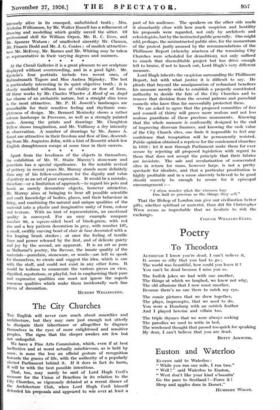Art Exhibitions
THE ROYAL SOCIETY OF PORTRAIT PAINTERS AT BURI.IN(.1■ HOUSE ; THE CHENIL GALLERIES : MR. STAITE MURRA.% POTTERY AT MR. PATTERSON'S GALLERY.] A LARGE exhibition of contemporary portraits makes grateful for Mr. Fry's term " applied art " in relation to it fessional portraiture—painting applied to social rather thou aesthetic ends. When the distinction is grasped and allowed for, a great deal, of amusement and human interest may obtained. The Royal Society of Portrait Painters show too many works to make a serious inspection in detail a thing lightly to be faced—after all, who could preserve interest if three hundred and sixty-four living beings were lined up together, though some were of distinguished origin and achieve. ment ? Human nature does not look more dignified on the,e walls than in the flesh—less so than in Mrs. Cameron's photographs. Yet the amount of competency, of skill indeed, in executing a difficult task, shown here is really considerable. A few older portraits are on loan—one by G. F. Watts, ample and flowing in design, sumptuous in colour and texture, but deriving both largely from Van Dyck and Titian ; one by Frank Holl, of the last- Duke of Cleveland, heavy and brown in the shadows, but having great concentration and weight of purpose ; and a rather dull; but subtly modelled painting by Orchardson.. These people seriously believed in their sitters as few painters seem to do to-day. Occasionally, there is a genuine revelation of character. Mr. Charles Cundall's portrait of The Artist's Mother is curiously and intensely alive in its cramped, unfurbished truth ; Mrs. Nicholas Williamson, by Mr. Walter Russell has a refinement of drawing and modelling which gently unveil the sitter. Of professional skill Sir William Orpen, Mr. R. C. Eves, and Mr. Spencer Watson ; of unaffected sincerity Mr. Clausen, 31r. Francis Dodd and Mr. J. G. Coates ; of modish attractive- ness Mr. McEvoy, Mr. Barnes and Mr. Whiting may be taken as representative in their varying degrees and manners.
At the Chenil Galleries it is a great pleasure to see sculpture displayed without overcrowding, and in a good light. Mr. Epstein's four portraits include two recent ones, of Itabindranath Tagore and Miss Andrea Mijinsky. The last is particularly interesting in its quiet objective truth ; it is closely modelled without loss of vitality or flow of form. Of three works by Mr. Charles Wheeler A Head of an Angel has charm of an archaistic nature, but a straight slim torso is the most attractive. Mr. P. H. Jowett's landscapes are remarkable for their sensitive feeling and rhythmic com- pleteness of design. Mr. Bernard Meninsky shows a rather solemn landscape in Provence, as well as a strongly painted nude. Among the prints and drawings Mr. Claughton Pellew shows imagination, and Mr. Vulliamy a dry intensity in observation. A -number of drawings by Mr. James A. Grant are attractive in their freedom and flow of line, descend- ing from Mr. Augustus John, with a hint of Rossetti which few English draughtsmen escape at some time in their careers.
Apart from the loveliness of the objects in themselves, the exhibition of Mr. W. Staite Murray's stoneware and porcelain has a special significance. In the notable revival of pottery in recent years Mr. Murray stands more definitely than any of his fellow-craftsmen for the dignity and value of pottery as an art of pure expression. It would be a mistake, therefore—or a limitation of approach—to regard his pots and bowls as merely decorative objects, however attractive. Mr. Murray aims at bringing to bear all possible scientific and craft knowledge of bodies, glazes, and their behaviour in firing, and combining the natural and unique qualities of the material into a plastic and imaginative unity of form, colour and texture. With no hint of representation, an emotional quality is conveyed. For an easy example compare number 90, a 'square-sided bowl of black-green, with red rim and a key pattern decoration in grey, with number 197, a small, swiftly curving bowl of Clair de lune decorated with a few leaping brush strokes ; at once the feeling of terrific force and power released by the first, and of delicate gaiety and joy by the second, are. apparent. It is an art as pure as Ilallarmels poetry, the flavour, the innate quality of the materials—porcelain, stoneware, or words—are left to speak for themselves, to create and suggest the idea, which is one with the stuff, and could not exist in any other form. It would be tedious to enumerate the various pieces on view, dignified, mysterious, or playful, but in emphasizing their pure and expressive qualities one must not ignore the superb sensuous qualities which make them incidentally such fine pieces of decoration.
HUBERT WELLINGTON.



















































 Previous page
Previous page